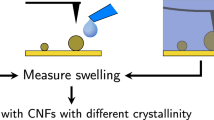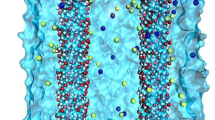Abstract
Tapping mode atomic force microscopy was used to study the bacterial polysaccharide curdlan deposited from dimethyl sulfoxide (Me2SO) and NaOH aqueous solutions. For curdlan in Me2SO, flexible single chains corresponding to a disordered conformation were observed at a concentration of 5 mg/l, and the chain diameter was measured to be 0.65±0.05 nm, which showed good agreement with the expected value of the single polysaccharide chain. Because the concentration of curdlan increased, the chains became more rigid and aggregated, subsequently, the network structures of curdlan appeared. However, curdlan samples deposited from a 5 mM NaOH solution showed entirely different conformations. The chains observed were almost in the form of micelles of several nanometers, which were supermolecular assemblies. The heterogeneously dense zones were observed as the curdlan concentration increased to 40 mg/l. When the concentration of curdlan was above 100 mg/l, which might cause the real concentration of curdlan on the mica substrate after drying treatment exceeding some critical value of gelation, gel network structures were formed. Keeping on increasing the concentration of curdlan, the image showed a more homogeneous fibrous network.








Similar content being viewed by others
References
Harada T, Masada M, Fujimori K, Meada I (1966) Agric Biol Chem 30:196
Deslandes Y, Marchessault RH, Sarko A (1980) Macromolecules 13:1466
Stipanovic AJ, Giammatteo PJ (1989) Curdlan and scleroglucan: NMR characterization of solution and gel properties. In: Edward GJ (ed) Polymers in aqueous media. American Chemical Society, Washington, DC, pp 73–87
Nishinari K, Zhang H (2000) Curdlan. In: Phillips GO, Williams PA (eds) Handbook of hydrocolloids. CRC Press, Washington, DC, pp 269–287
Ogawa K, Watanable T, Tsurugi J, Ono S (1972) Carbohydr Res 23:399
Saito H, Ohki T, Sasaki T (1977) Biochemistry 16:908
Konno A, Harada T (1991) Food Hydrocoll 5:427
Gao Y, Fukuda A, Katsuraya K, Kaneko Y, Mimura T, Nakashima H, Uryu T (1997) Macromolecules 30:3224
Jeon KJ, Katsuraya K, Inazu T, Kaneko Y, Mimura T, Uryu T (2000) J Am Chem Soc 122:12536
Zhang H, Huang L, Nishinari K, Watase M, Konno A (2000) Food Hydrocoll 14:121
Bluhm TL, Deslandes Y, Marchessault RH, Perez S, Rinaudo M (1982) Carbohydr Res 100:117
Zhang H, Nishinari K, Williams MAK, Foster TJ, Norton IT (2002) Int J Biol Macromol 30:7
Balnois E, Stoll S, Wilkinson KJ, Buffle J, Rinaudo M, Milas M (2000) Macromolecules 33:7440
Kirby AR, Gunning AP, Morris VJ (1996) Biopolymers 38:355
Bae AH, Lee SW, Ikeda M, Sano M, Shinkai S, Sakurai K (2004) Carbohydr Res 339:251
Vuppu AK, Garcia AA, Vernia C (1997) Biopolymers 42:89
Ikeda S, Shishido Y (2005) J Agric Food Chem 53:786
Tada T, Tamai N, Matsumoto T, Masuda T (2001) Biopolymers 58:129
Dais P, Vlachou S, Taravel FR (2001) Biomacromolecules 2:1137
Cowman MK, Li M, Balazs EA (1998) Biophys J 75:2030
McIntire TM, Brant DA (1996) Biopolymers 42:133
Fulton WS, Atkins EDT (1980) The gelling mechanism and relationship to molecular structure of microbila polysaccharide curdlan. In: French AD, Gardner KH (eds) Fibre diffraction methods. American Chemical Society, Washington, DC, pp 385–410
Jin Y, Zhang H, Yin Y, Nishinari K (2006) Carbohydr Res 341:90
Kasai N, Harada T (1980) Ultrastructure of curdlan. In: Fibre diffraction methods. American Chemical Society, Washington, DC, pp 363–383
Acknowledgement
This work was supported by the National Natural Science Foundation of China (20274025).
Author information
Authors and Affiliations
Corresponding author
Rights and permissions
About this article
Cite this article
Jin, Y., Zhang, H., Yin, Y. et al. Conformation of curdlan as observed by tapping mode atomic force microscopy. Colloid Polym Sci 284, 1371–1377 (2006). https://doi.org/10.1007/s00396-006-1503-x
Received:
Accepted:
Published:
Issue Date:
DOI: https://doi.org/10.1007/s00396-006-1503-x




